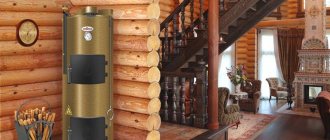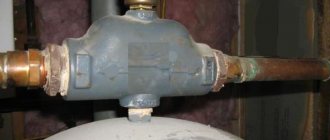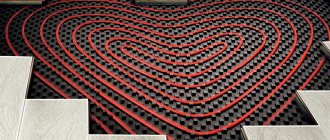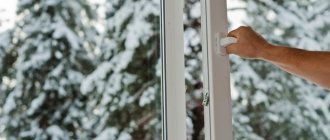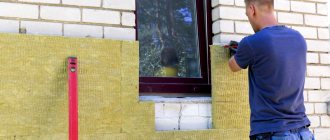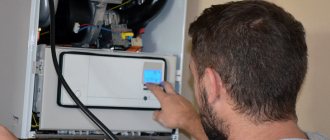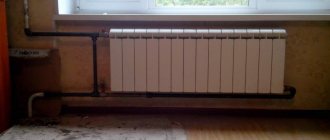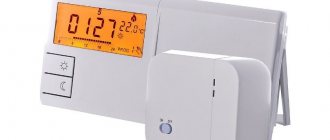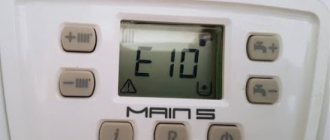During the beginning and end of the summer season - namely early spring and late autumn - the temperature outside is hardly above zero. That’s why it’s cold in the country house. This problem is easy to fix - you just need to take care of heating your home. How exactly to do this? Summer residents often use heaters , but these devices require a lot of electricity to operate. Moreover, air heaters do not provide a favorable microclimate in the house; they do not dry out the premises after winter.
Heating a dacha with heated floors
The best option can be considered a warm floor in the country. But which heating system should you choose? Is it necessary to prepare a country house for installation? How exactly is underfloor heating installed? You will find answers to all these questions below.
Main or additional heat sources for a country house
Electric floor heating can be performed specifically on a dilapidated floor: on ceramic tiles or parquet.
In this case, it is most ergonomic to use heating mats. They make it possible to easily improve thermal comfort in a room that is already in use, without raising the floor level significantly and creating additional load on the ceiling.
When planning the installation of electric underfloor heating in a dilapidated building, you should not forget that as the main source of heat it can only be justified in buildings with good thermal insulation. If the total heat loss through the outer walls, floor and roof is enormous, in other words, exceeds thermal standards, underfloor heating alone will not be enough to heat the room to the required temperature.
In this case, electric underfloor heating can only serve as an addition to a second type of heating, for example a system with radiators. Here we are not talking about reducing electricity consumption but about floor temperature. It cannot be larger than the defined values. Otherwise, the floor must provide no more than pleasant warmth, neutral from a physiological point of view.
It is generally accepted that in rooms such as the living room or kitchen, the floor temperature should be a maximum of 29°C, and in the bathroom - 34°C. In areas under the windows, along the outer walls, the floor temperature can be as high as 35°C. But this is often not enough to compensate for heat losses at home and ensure a comfortable temperature in the room during frosts reaching -15-20°C (calculated temperature taken depending on the region of the state).
Insulation on concrete screed
Concrete floors are most often insulated by laying penoplex under the screed. This method is quite simple, although labor-intensive, the result is reliable and durable. In order for the insulation to lay down in an even layer, the concrete base should not have differences in height of more than 5 mm. Also, there should be no cracks through which moisture can penetrate.
To work you will need:
- penoplex insulation;
- waterproofing film;
- damper tape;
- reinforcing metal mesh with a cell of 100x100 mm;
- profiles for beacons;
- building gypsum;
- cement and sand;
- tools.
Step 1. The surface is primed in 1 or 2 layers, depending on the porosity of the base.
Step 2. After the primer has dried, apply damper tape around the entire perimeter of the room at the junction of the walls and floor.
Laying self-adhesive damper tape
Step 3. Line the base with overlapping strips of film and secure its edges with tape. The width of the overlap should not be less than 10 cm. The edges of the film along the perimeter are placed on the wall, also to a height of 10-12 cm.
Step 4. Install the thermal insulation layer. To fix the slabs, you can only use glue, but many craftsmen additionally secure the insulation slabs with mushroom dowels, one in the center of each slab. At the joints, the insulation is tightly connected using a tongue-and-groove system. In cold regions, laying penoplex should be carried out in 2 layers, with the obligatory displacement of the upper slabs relative to the lower ones. If suddenly there are gaps between the insulation, they must be blown out with foam so that the solution does not get there when pouring.
Installation of thermal insulation boards
Glue is applied to the boards. Additional fixation with dowels
If necessary, the slabs are cut to the required size.
How and how to cut polystyrene foam and polystyrene foam
Scheme for applying glue to polystyrene foam
How to properly glue polystyrene foam
Step 5. Mix gypsum or cement-sand mortar and install beacons on top. The distance between the beacons is about a meter, each profile is strictly leveled horizontally. If the beacons are not located in the same plane, the screed will be uneven, which will complicate the installation of the floor covering in the future.
Beacons are fixed with mortar
Step 6. Prepare a solution for the screed in the proportion of 1 part cement to 3 parts sand. The floor is poured in parts, starting from the far corner of the room. Pour the solution between the beacons, then stretch it with the rule. If voids form during the leveling process, apply the missing mortar with a trowel and level it again.
Pouring the mixture between the beacons
Alignment is performed by the rule
Step 7. After a couple of days, the profiles can be carefully removed so as not to damage the surface of the screed, and the resulting grooves are filled with fresh solution. If desired, the beacons can be left in the screed; this will not affect its strength.
After 28 days, you can lay the topcoat. The entire time the screed is drying, it should be protected from drafts and sunlight. From time to time the surface must be moistened, especially in hot weather, as rapid drying promotes cracking.
The screed is covered with film for more uniform drying
Methods for insulating a wooden floor
SNiP 02.23.2003 clearly defines the standard values of heat transfer resistance and requirements for thermal engineering calculations, which should be used to guide the choice of insulation thickness. Many inexperienced self-taught builders mistakenly believe that the thicker the insulation, the better. If the insulation is too thin, the house will be cold; if it is too thick, you will be wasting your money.
That is why it is important to choose the right layer thickness depending on the thermal insulation material and the material from which the walls are made. The climatic conditions of the area in which the house is located also play an important role.
All these nuances are described in detail and taken into account in SNiP.
Without going into the intricacies of thermal engineering laws, experts advise building floors over a cold basement with insulation 12 cm thick for the middle zone, 20 cm for the northern regions, and insulating the interfloor floors with an 8-centimeter layer.
It is much more convenient to insulate wooden floors in a house than walls or ceilings, if only because their design involves the use of joists and a subfloor. You can pour expanded clay, shavings into the space between the joists, lay the slabs neatly and tightly, or blow everything out with foam. Thus, insulation with any material occurs according to the general principle - it is placed between the joists and covered with a finished floor (in some cases, additional hydro- or vapor barrier is required).
Insulation of floors with low underground
In houses with a limited subfloor size, it is impossible to place thermal insulation material as usual - between the joists. To do this, you will have to dismantle the entire flooring, so if this is your case, get ready for labor-intensive work.
Sequentially perform the work:
This method describes how to insulate a floor in a country house if construction has already been completed, but it is best to take care of thermal insulation at the time of designing the house.
Insulation of floors above a high cellar
The nature of the actions in this case is no different from the previous one, except that you do not need to increase the height of the logs, dismantle the finished floor covering and the stages of work should be performed in the opposite order. The only caveat is that for insulation in this way you cannot use bulk materials - expanded clay or sawdust.
Progress:
Everyone decides for themselves how to insulate the floor, but it must be done in any case. A warm floor in a dacha will keep you warm in the winter and give you coolness in the summer, reduce heating and electricity costs, and become the key to the health and comfort of the residents.
Insulation forms
All existing types of insulation can be divided into groups based on the shape of the material. Each of them has its own advantages in certain conditions. Let's take a closer look at them:
Liquid heat insulator
Liquid thermal insulation is a material that is applied by pouring or spraying. In air they harden or (more often) foam, forming a continuous sealed canvas. The disadvantage of such materials is the need to use special equipment
However, there is an important advantage - liquid materials can be applied to any surface with a large number of small parts, potholes or other flaws. In any case, the coating will be smooth and airtight
In addition, the thickness of the layer is relatively small and does not create excessive load on the supporting structures.
Liquid types of insulation include:
- polyurethane foam;
- penoizol;
- insulating paint;
- liquid rubber.
The use of such materials is limited due to installation difficulties and high cost.
In slabs
Slab types of insulation are convenient because they are able to retain their shape during installation and do not require the installation of load-bearing structures. These include the following materials:
- Styrofoam;
- penoplex;
- stone (basalt) mineral wool;
- wood concrete;
- foam glass.
The disadvantage of slab forms is the need for careful preparation of the base. In a house without basement heating, the condition of the surfaces is rarely ideal. It is necessary to level the plane, eliminate potholes, dents and other defects. Installing insulation on uneven surfaces will not bring the expected effect. Moreover, water will gradually accumulate in the dent cavities, which will lead to gradual peeling of the insulation. Before installation, you have to do careful preparation, apply a leveling layer of plaster or sheathing to the subfloor.
In rolls
Rolled types of insulation represent the most extensive group. These include:
- mineral wool;
- penofol;
- isolon.
The advantage of rolled materials is the ability to be installed on convex or concave bases. They can be mounted on cylindrical walls, pasted over spherical surfaces, and complex shapes. Disadvantage: lack of self-supporting ability. Before insulating the floor in a private house with rolled materials, you will need to assemble additional supporting structures, use adhesives or other auxiliary materials.
Bulk thermal insulation
Bulk materials are used only on horizontal planes - for insulating floors, attics, ceilings, and ceiling slabs. This group includes:
- expanded clay;
- sawdust;
- expanded polystyrene granules;
- perlite
The use of such insulation materials is limited due to the peculiarities of their structure. The best option for use is floor insulation in a wooden house. The main advantage is the ability to extract and reuse the material. The disadvantages include the need to create a fairly thick layer of backfill - the desired effect appears with a layer thickness of 25 cm. Because of this, they are most often used to insulate floors in a private house with a cold subfloor.
General principles for arranging wooden floors
If you are planning to install floors made of natural materials in your country house, plan the work for the end of spring
This is important because during this period the tree will absorb less moisture. If the assembly of floors in a cottage or house cannot be postponed until the recommended time and the work needs to be done in the summer, choose a dry, hot period, without heavy rains and dew.
Regardless of the method used to install floors, it is extremely important to pay maximum attention to the quality of the lumber. Wood must be treated with special agents against rotting, moisture, insects, as well as a fire retardant composition
Real heating with electric floors
The most reasonable option for heating a house with an electric floor is to use a cable electric floor. In this option, you have the opportunity to supply much more electrical power to the heating device and, accordingly, receive greater thermal output.
Naturally, all equipment and controllers in this option must be used with a higher maximum power.
Installation of heated floors
The easiest way to install a heated floor yourself is thermal film, the installation of which does not require much time and effort. During the work you will need the following:
- heat reflecting material;
- thermostat;
- electrical power cable;
- electrical tape (mounting tape);
- rivets and pliers;
- mounting grid (if you plan to make a screed).
Scheme of a warm water floor.
Thermal film is placed at a distance of 50-70 cm from the walls around the perimeter. A very important point: you cannot place furniture on it and do not install a plinth on top of it. The thermal film strips are fixed with clamps parallel to each other and insulated with tape. It is not necessary to make a screed; you can immediately lay the covering. However, if you plan to lay a soft covering, for example, carpet or linoleum, then it is worth giving the base additional rigidity by laying sheets of plywood or MDF.
Cable heating systems require additional dexterity and certain skills when installing. For installation you will need the following materials:
- thermal insulation, which can be solid foam with a density of at least 20 kg/m, polyurethane or hard mineral wool;
- polyethylene film;
- metal mesh for fastening the heating cable, it ensures insulation of the cable from the surface of the thermal insulation;
- cable ties or soft binding wire to secure the cable to the metal mesh;
- mounting tape (used instead of metal mesh);
- heating cables;
- thermostat.
Before you begin installing a heated floor, you need to develop a project and prepare the base; it must be level and clean. A layer of thermal insulation, plastic film and metal mesh must be laid out on the prepared surface. Be sure to follow this sequence.
According to the heated floor design, the heating cable is attached to a metal mesh. You can secure it using cable ties or soft binding wire. you can also use a special mounting tape if the thermal insulation will be filled with a special solution (for fastening the heating cable).
Once you have completed installing the cable, you can move on to the next step - installing the temperature sensor. Then the entire surface is filled with sand-concrete mortar, the thickness of which must be at least 50 mm. You can also use a self-leveling (self-leveling) solution. In any case, the cable must be completely “sunk” in the solution from start to finish. After the screed has completely dried, you can begin laying the final coating.
Installing water heating is technically more complex. In the process of installing a water heated floor, the following stages can be distinguished:
- Development of a project, which involves dividing the area of the premises into sections whose area does not exceed 40 sq.m.
- Laying insulating material on the prepared surface (necessary to avoid heat loss).
- Installation of reinforcing mesh and laying of pipe contours.
- Pressure testing of the heating system.
- Pouring concrete.
- Final finishing.
If you doubt your own abilities, it is better to seek help from professionals. This way you will save money and avoid disappointment.
Concrete floor
The internal surfaces of the basement of the dacha are cleaned of dirt and grease stains with your own hands. If damage to a building material by fungi or mold is detected, measures must be taken to destroy them. It is better not to waste time and money on experiments with folk remedies. The necessary chemicals can be purchased at any hardware store. The seller will give advice on their use.
- The cleaned base is leveled - plaster. You can use the traditional composition - sand, cement (3/1).
- Treatment is carried out with a moisture-proof primer or bitumen mastic.
- Thermal insulation material is attached to the floor slab - mineral wool, penoplex, polystyrene foam. The insulation is secured with dowels or adhesives. The combination of two types of fastening is more reliable.
- When using mineral wool materials, a layer of vapor barrier and reinforcement is required.
Then the interior finishing work is carried out - plastering, whitewashing.
Installation of underfloor heating system cable
The cable is laid on a layer of thermal insulation (expanded polystyrene or mineral wool), covered with moisture-proof insulation (film) and a narrow layer of cement paste. The film protects the thermal insulation from the penetration of liquid from the solution. If the cable is laid in wet areas (in the bathroom or kitchen), moisture-proof insulation must be placed under the top layer of the floor.
The thickness of the thermal insulation layer depends on the base and the type of premises underneath:
- a narrow layer (3-5 cm) is laid in floors above heated rooms;
- a thicker layer (7-10 cm) - in floors above basements or unheated rooms;
- The thickest layer of insulation (more than 10 cm) is needed for floors on the ground, floors with open space under the floor, floors above a bay window or loggia.
In addition, the design of the floor is important: the higher the thermal insulation properties of the flooring material, the thicker the layer of thermal insulation needs to be laid. Heating cables are fixed to a tape or mounting grid at the required intervals, and then covered with a layer of cement mortar with the addition of a plasticizer or a layer of gypsum or cement screed.
Attention! In underfloor heating systems installed in wooden floors on joists, heating cables are laid brightly on thermal insulation and mortar
are not covered. An air gap of 3-5 cm is left between the heating wooden covering and the body elements.
Floor design elements
If the flooring is laid on the ground, then its pie should look like this:
- The soil must be leveled, leveled and compacted.
- Next, an underlying layer of crushed stone, slag, gravel is arranged; sand can be laid (10 cm thick). The layer is leveled and compacted with rollers.
- The waterproofing layer prevents water from accessing structural elements. It protects the structure of the overlying deck from rising groundwater levels. This can be two layers of roofing felt, all kinds of waterproofing films, membranes.
- If the base is insulated, then the next layer is thermal insulation. If this is a summer cottage only for summer holidays, then you can do without it. Thermal insulation, as a rule, is made of expanded clay, slag approximately 150 mm thick.
- Concrete preparation device, grade 100 – 150, 100mm thick.
- Leveling screed made of mortar grade 100-150, 25 - 30 mm thick.
When laying the base on floor slabs, the pie will be slightly different. As a rule, this is the attic floor:
- The soundproofing layer is not always carried out, since this is a dacha and there are no neighbors above. But if you decide to arrange a bedroom there for relaxation, then, if desired, you can also add a soundproofing layer.
- A leveling layer of cement, polymer-cement or other compositions with a thickness of 20-25mm.
We took a tour of the main elements of preparing the base for flooring. According to the project, some of the structural elements may be added or absent - everything is individual.
The base is ready, let's move on to choosing the finishing floor covering.
Warm floor on a concrete base
For the liquid floor line and for the cable sections, it is necessary to provide a fastening system. The best option is reinforced mesh. It is necessary if the system is subsequently covered with screed or tile adhesive.
The floor line to the mesh is reinforced with tapes with reverse teeth. Staples, a stapler, and mounting tapes with locks are used as fastening elements.
- The ends of the liquid line are connected to the distribution comb. Pipes lead from it to the heat exchanger, which is located in the firebox. The cable is connected to the thermostat.
- No fastenings are needed for cable and carbon mats. They are produced in rolls. The rolls are rolled out over a heated area. If it is necessary to rotate the cable mat, then the mesh is cut. The conductor remains intact. The system can be rotated at any angle. To rotate the carbon mats, the connecting wire is cut. The integrity of the rods is not violated.
- The thermal film is cut along the dotted lines, forming sheets of a certain length. The distance between the sheets should be 1 cm. Secure the tape to the base with tape.
- Mats and sheets of thermal film are connected in a parallel way.
- A temperature sensor is placed on the surface of the electric floor. A niche is being created for him.
- Connect the electrical wires from the “warm floor” and the temperature sensor to the regulator.
System selection
There is electricity at the summer cottage. Water is often supplied only on certain days of the week; houses are usually not connected to the gas mains. Liquid heating is installed only if the room has a stove that runs on solid fuel.
It is advisable to install water heating in a two-story house or in a cottage with a large heating area.
If the summer house does not require heating units, then electric heating elements are used as heating:
- cable section; a conductor is laid on the floor; It is recommended to cover it with a 5 cm screed or tile adhesive; for normal heating it is enough to cover 70% of the active area; Cables are not laid under furniture and household appliances; the circuit is mounted with a double “snail” or double “snake”; in this case, the cold circuit is located between the hot turns of the cable; heating is effective over the entire floor surface;
- cable mats; the system is easier to install than sections; the conductor is secured to the mesh with a snake; heating may be uneven; the further away from the power source, the cooler the cable will be;
- carbon rods; the rods are assembled into mats; installation is not difficult; cover the mats with screed or tile adhesive;
- carbon thermal film; the system is installed on any surface; laminate is immediately laid on it; for linoleum you will need to form a covering from plasterboard; the film can be covered with fiberboard or clapboard, but to cover it it is necessary to install logs and make lathing; It is not recommended to violate the integrity of carbon elements;
- electric liquid heating; a pipeline is laid on the base; it contains a heating cable; pipes are filled with propylene glycol; the coolant does not circulate through the main line; it heats up due to the cable, transfers heat to the floor; the conductor is connected to the network.
We recommend: What is National Comfort underfloor heating?
For a country house that does not have a liquid or solid fuel stove, it is recommended to install electric heating systems. They consume less energy than air heaters.
Heating can be turned off if the country house is not in use. It will take 48 hours to achieve normal thermal conditions in the premises, so it is recommended to turn on the system long before arriving at the site.
If there are frequent power outages in the area, then the optimal heating system will be a liquid circuit from the furnace. A “warm floor” in a country house is installed without a circulation pump. Pipes are brought to the floor main at an angle.
For the return pipe, the slope is made towards the boiler. The coolant circulates due to gravity. The stove is chosen to burn for a long time so that the coolant does not heat up to a high temperature.
Water-type warm floor
The design of this system is simple: heat comes from water, which passes through pipes located in the screed. This system includes:
- pipes;
- thermal insulation;
- fastening materials,
- components for making expansion joints,
- manifold with fittings for connecting pipes to the heating system.
This system uses metal-plastic and polyethylene pipes. They should be laid in the same way as an electrical cable - with a snake. The distance between the turns should be no more than 30 centimeters. Installation of water heated floors is much more difficult than electric ones. The step-by-step instructions are as follows:
- The beginning of the installation of this system will be the installation of a manifold and a unit in the form of a block, which will combine a pump and a mixer. It is the unit that will ensure that the temperature you select is maintained. The block is responsible for distributing water among the turns. This entire structure is attached to the manifold cabinet.
- The next step is to prepare the floor, it is worth clearing it of debris and checking the evenness of the surface.
- Thermal insulation tape is laid around the perimeter.
- Then it is worth laying a vapor barrier to protect the system from moisture from below.
- Next, for quick installation of pipes, the floors are lined with polystyrene foam boards. The slabs are laid overlapping; for this they have special grooves.
- When laying pipes according to the diagram, be sure to maintain the distance between turns. A spring conductor is used to fix the bend.
- When the design of the circuits is completed, the ends of the pipes must be connected to the distribution manifolds, and servos are installed. They make it possible to regulate the operation of the entire structure using a room thermostat.
- Before starting the system, it will need to be checked for leaks, only after that you can make a concrete screed. The floor can be put into operation no earlier than after 28 days.
To summarize, I would like to note that electric-type underfloor heating is better suited for summer cottages. If you want to make a water-type structure, you must be prepared for the fact that at the end of the summer season you will have to drain the water from the pipes. Another advantage of an electric floor is that it is more economical compared to others. Now you know what a heated floor is and which option is best for your suburban area. You can safely begin installing it, and let your home be warm.
Thermostats
Manufacturers offer many different types:
- Mechanical (analog) regulators are the simplest and most reliable.
Appearance of a mechanical thermostat
- Digital - with liquid crystal displays, which display several parameters: the temperature of the floor covering, the air in the room, and sometimes the current time.
Appearance of a digital thermostat
- Digital programmable thermostats - allow you to set a certain temperature at different times of the day (day - night) or by day of the week. In the absence of people, the temperature drops and rises before arrival, this makes the operating mode more economical.
Programmable thermostat
- Thermostats with remote control can be controlled by a remote control in the infrared range, as on TVs, via a radio channel. More expensive models work over the GSM network, over the Internet online, and are controlled from an iPhone, tablet or PC, from any place where there is a cellular connection or cable Internet.
Thermostats differ in their controls: in mechanical models, the wire resistance is changed by a moving contact on a plastic disk in the device body.
In digital regulators, the resistance is changed by a microcircuit, which includes an electronic switching relay. Control can be carried out by mechanical buttons or touch segments on the display, as on mobile iPhones or tablets.
Regardless of the thermostat model, the control units are connected according to a typical scheme to elements with the same functional purpose:
- to 220V network;
- to the heating cable;
- to one or more temperature sensors;
- through grounding.
For safety reasons, all electrical heating systems in private households are connected to the network in the distribution panel through a short circuit protection circuit breaker and an RCD (touch protection device).
Heating mat
Fiberglass heating mats, which are equipped with a heating cable system, are also popular among consumers. The advantage of such products is their ease of installation, because their installation does not require such a labor-intensive procedure as additional pouring of concrete. The system is fixed in a layer of adhesive composition designed to fix the tiles. Thanks to this, the final layer of screed does not exceed three centimeters.
Heating mat
The devices are sold in rolls, which makes installation of the system easier. The technical characteristics of such products are exactly the same as in the case of prefabricated heating cable systems.
Types of heated floors and their features
There are several heating options:
- water;
- electric;
- infrared.
Water heated floors are a simple and effective solution. To install it, heating elements are placed in the concrete screed. As a rule, polyethylene and metal-plastic pipes (less often copper) are used. Hot water flows through them.
Unfortunately, this type of underfloor heating cannot be used in apartment buildings, as this disrupts the overall heat supply system. Of course, if you wish, you can try to get permission and coordinate the project with utility services. Water heated floors are an excellent solution for a private home; they do not require approvals, are safe, durable and economically attractive. However, it requires maintenance (filter replacement, etc.)
Electric heated floors are installed in a similar way, only the main element is a shielded heating cable with temperature sensors. There are different options here: heating cable, film material and special heating rods, depending on whether you are ready to raise the floor level. The heating cable is laid under a screed 5 cm high. When using a thin heated floor, namely mats, a screed is not required.
Diagram of a riser for a heated floor system.
You can use single-core or double-core heating sections, which are suitable for heating a wide variety of premises (residential, office and industrial). Using a thermostat, you can control the climate by setting the optimal temperature. In addition, you can monitor your energy consumption. Electric heated floors are more expensive than water ones.
Infrared heated floors (ITP) are very popular. A significant difference of this type is the use of infrared radiation with a length of 5-20 microns. This option is economical in terms of energy consumption.
Errors
Below are some points that should not be allowed during the process of insulating floors:
- You cannot partially insulate a room if it requires major repairs;
- If you have a conventional meter, it is unacceptable to use an infrared or water floor;
- Cheap materials in most cases are harmful to health. They can not only cause allergies in humans, but also lead to undesirable consequences;
- During the installation of a heated floor system, the heating circuits must not be kept empty while pouring the screed. There should be no heating;
- It is prohibited to use expanded polystyrene and polystyrene foam to fill the space between beams in a wooden structure that consists of several floors. When fastening the sheets, they are poorly insulated and therefore accessible to oxygen. Therefore, during the combustion process, fire can easily penetrate inside.
You can watch the following video about mistakes when insulating the floor in a private house.
Features of installing products with your own hands
If you are undertaking the installation of an electric floor system in a country house or country house with your own hands, then first you must carefully study the installation instructions, which are attached to the products and contain all the necessary information regarding installation, features of operational use and general safety.
Film placement diagram
A list of several rules will help avoid such problems:
- Be sure to calculate the area that needs heating and choose the system rationally.
- You cannot lay the cable under pieces of furniture that do not have high legs, and the infrared film must be placed only in an open space free of furniture.
- The base must be thoroughly leveled and dried.
- Under no circumstances should you shorten or lengthen the cable, cut it or perform other manipulations.
- Turning on the system is allowed only after the screed layer has completely hardened and dried. This usually takes from 28 days to a month, at least.
If you plan to use tile products as flooring, then it is best to choose a cable-based device, since this option is the most budget-friendly and suitable for this case.
Range of film products
First of all, you should prepare a place to place the temperature regulator, form a groove where the electrical wiring and temperature sensor tubes will be hidden. The output of the mounting ends will also be located in this area.
After this, the base is leveled, cleaned of dust and debris and covered with a layer of primer. Then the heat-insulating material is laid, and the corresponding sections of the mounting tape are glued according to the laying diagram.
Material cutting
Key points that should not be forgotten:
It is necessary to check the electrical resistance in the network. The cable should be taut during installation, but without much effort. It is necessary to take into account the minimum permissible bend. On straight sections you need to use special couplings. Do not allow the cable turns to intersect or touch.
Next, the temperature regulator is installed and connected to the electrical network. When installing a temperature sensor, a corrugated tube is used, which, for ease of repair work, should be placed between the turns of the cable.
After all connections are made, the system is checked for damage, resistance measurements are taken on the sections and the sensor and checked against the numbers in the documents. When the screed is completely dry, the device can be turned on.
Wood flooring installation process
In the process of constructing a wooden floor covering, whether in a country house or in a brick cottage, there is nothing complicated: the work can be done with your own hands. However, in order to obtain a beautiful, strong and durable coating as a result of the work, it is necessary to take into account many nuances when performing it, and also to study well the theory of floor laying.
In a brick house, cottage or small wooden building, you can arrange the floors with your own hands in different ways. Let's look at the two most popular options:
- A floor covering created on a rough layer and with an additional layer of insulation (sound insulation), located on a base of soil or on overlapping beams;
- The floor is made of wood, built on a concrete base with an insulating layer.
In country houses, the first option is more often used. Moreover, this method creates floors on the first floor or basement, and it can also be used when arranging floor coverings on different floors of the building.
In the second option, the flooring design is built completely differently and can be modified and modified to reduce costs. More often, this method is used to make floors in brick cottages and apartments; it makes sense to lay floors in the kitchen on a concrete base.
Installation of mats
Making a system from heating mats is a less labor-intensive process than laying cables.
First, the mats must be laid out on the floor for estimation. They are laid with the wires down. After this, carefully cut the mesh fibers in the right place, taking care not to damage the cable.
Then you need to lay out the pieces of the mat so that they cover the entire free surface in the room. Mats with one-sided power supply are more ergonomic to install. Recently they have become cheap on the domestic market.
Mats with power connections on both sides are more difficult to lay so that the ends of the cables reach the junction box together.
Once fastening and installation are complete, the mats are covered with a thin layer of plastic mortar and a new floor covering is laid on it. In bathrooms and all other wet areas, under the floor covering, for example, under tiles, it is necessary to additionally install moisture-proof insulation.
If the coating is thin, the floor level will rise by only 1-2 cm.
Attention! Heating cables should not be laid above expansion gaps because they are easily damaged in such places. As a result, this may lead to a heating system failure
If the heating element is damaged, safety will be ensured by a differential involuntary switch, which will turn off the electricity supply, preventing electrical breakdown.
We insulate the wooden base
Insulating the floor of a country house involves several stages, the correct implementation of which requires detailed instructions:
- We prepare the foundation. To do this, it is necessary to dismantle the old coating.
- We lay logs on the subfloor. The distance between them depends on several aspects:
- Thickness of the finished floor material (boards, laminate, etc.).
- Thickness of insulation boards.
The average distance between the logs is 60-80 cm.
- We fix the beams to the base using anchors.
Logs with installed film and insulation.
- We lay a film of 150-200 microns on the joists, without stretching it, but laying it in the spaces between them.
- We lay insulation boards. They should fit tightly between the joists.
- A waterproofing material – polyethylene film – is placed on top of the lag. It overlaps onto the bars. The joints are sealed with tape.
- The final layer is the finishing coat.
Advantages and disadvantages
Before installing a heated floor, it is necessary to evaluate all the pros and cons of this design. The benefits include:
comfort and safety; efficiency (compared to other methods of heating a room, power consumption is lower); aesthetics; hygiene (especially important for the bathroom); easy to install and requires no maintenance (electric heating); Suitable for all types of floors (i.e. can be installed under carpet, marble, wood, etc.). Heated floor temperature control diagram
Scheme for adjusting the temperature of a warm floor.
First of all, the materials used for final finishing must be safe so that during the heating process no harmful substances are released that can harm people.
If you decide to install a heated floor, then you should not use a coating that will interfere with heating. For example, a coating with double insulation will not work.
Operating conditions are directly related to the materials used. If you have chosen parquet, then you must take into account that the temperature should not exceed 24 degrees, and the power should not exceed 130 W/sq.m. Many experts do not advise laying parquet and cork on a heated floor. Parquet is too capricious a material, and cork has low thermal conductivity.
Flaws:
- financial costs associated with installation;
- the floor heating system emits an electromagnetic field, but it is minimal and safe for the inhabitants of the house (electric heating);
- maintenance required (water heating).
Conclusion
Warm floors with dry screed using Finnish technology are a basic option that can be tailored to specific conditions and needs. All the subtleties and nuances are in the topic of heated plasterboard floors. In the article about heating a private home, the most economical heating method is selected. And in the video about engineered heating equipment - expert advice on choosing.
Subscribe to our Telegram channelExclusive posts every week
Two structures could serve as support for the lag
- Special support beams that were placed in nests arranged in the stone foundation of the house or rested on the lower crown (if the house was wooden).
- Brick columns, which were installed in the underground space and could serve as both a base for support beams and a support directly for the logs.
Nowadays, when there is a wide choice of building materials, including concrete, a concrete slab or pad is often used as the base of the ground floor.
And, if the slab is mounted directly on the foundation, then the cushion is poured inside it and distributes the load directly onto the soil located inside the foundation contour.
Let's talk about the finishing coat
Before laying down the finishing coating, you should decide what kind of material you need. After all, each room has its own load and humidity level. In addition, when planning the installation of floors in a dacha, you need to take into account that in winter the room will not be heated.
Concrete covering
A concrete floor for a summer house can theoretically also be installed independently. If you make it perfectly smooth and paint it, it will have a fairly good appearance. This coating is strong and durable; you will need to refresh the paint every few years and the floor will be like new.
But no matter how hard you try, concrete is concrete, it will be cold, if you cover it with a carpet or bedding, the cold will still be felt. Even in the summer, doctors do not recommend walking barefoot on concrete.
This option may be suitable for a summer kitchen, garage or outbuildings. In residential premises, a concrete screed is used as the basis for the final coating.
We use natural wood
The installation of natural wood floors in a dacha is a classic. People have been laying them for hundreds of years. The price of such a coating will be average, but wood is a natural material and requires careful processing and care. In particular, good waterproofing of the wooden floor in the country house must be provided. Otherwise, the tree can quickly deteriorate.
This coating is also convenient because with a good base and well-equipped waterproofing, you will not need powerful insulation. The covering is covered with a tongue-and-groove board with a thickness of at least 40 mm, which itself is quite warm.
When deciding how to paint wooden floors in a country house, experts advise paying attention to acrylic varnishes and paints. In the old days, the floor was traditionally painted with oil paint, of course it is practical and durable, but with such a coating the wood does not breathe and the whole meaning of naturalness is lost
A classic wooden floor is installed exclusively on joists, because it requires constant ventilation from below. DIY installation instructions are quite simple. Initially, waterproofing is laid, wooden logs are mounted on it, onto which a tongue-and-groove floorboard is already nailed. Insulation is laid between the joists.
Laminate
Laminate coating appeared about 20 - 30 years ago, and currently it is one of the most popular. The appearance of the laminate can be anything, the range of colors here is one of the widest. As a rule, it emits natural wood.
The advantages include a low degree of abrasion, ease of installation and durability. If we talk about the disadvantages, then this coating requires a perfectly flat, waterproofed base. The price of expensive types is steep, but budget options are afraid of moisture and cannot withstand heavy loads.
Linoleum
This material can deservedly be called the king of floors not only in the country, but also in most other residential or office premises. It can be thin or dense. Smooth and corrugated surfaces with varying degrees of stability are available. Linoleum behaves well in a humid environment and is not afraid of temperature changes, plus laying linoleum does not require high professionalism.
Linoleum has few disadvantages. In fact, experts consider the most sensitive area to be the ability to push through the material. Linoleum is afraid of sharp heels and heavy furniture. Plus, its installation requires a perfectly flat surface.
Wood is a material valued for its environmental friendliness, aesthetics and durability, and therefore it is not surprising that dacha owners choose wood as a construction resource for constructing floors. Coverings made of natural materials are laid not only in the country - in small summer houses, a wooden floor can be laid in a brick cottage or a foam concrete structure. How to lay a wooden floor in a country house and whether it can be done with your own hands - we’ll figure it out together.
Is it necessary to carry out insulation?
It is logical to assume that since you have read this far, it means that the topic interests you. In general, thermal insulation is not always necessary. Why bother with the floor if you hardly use your summer house building in cold weather? It is advisable when used in winter or when the temperature outside the window is below a certain level. In other cases, it is possible to do without not very complicated, but still time-consuming work.
Another thing is that insulation somehow increases the durability of the structure. When cold penetrates indoors, it negatively affects various materials to one degree or another. For example, some finishing compositions may react negatively to low temperatures. Without heating, they lose their performance characteristics.
Plus, thermal insulation will not be superfluous, if only for the reason that sometimes you want to go to the dacha even in winter. Spending the New Year or another significant holiday outside the city - what could be better? The presence of insulation on the floor side will allow you to feel comfortable in any season.
Heating on a wooden floor
When working with wood flooring, you should always remember that the heating elements are located below the floor surface. There are several installation methods:
- the pipeline or cable sections are routed between the lags on the surface of the gypsum plasterboard; to pass the elements through the logs, holes are made; they install corrugated tubes or insulation for pipes;
- if the floor is made of boards, then a contour is drawn on the surface; For this purpose, a wall chaser is used; foil material is placed in the grooves;
- make the contour from plywood or lining; distance between workpieces 50 mm; metal thermal distribution plates are installed in the resulting niches; reflective material is placed in them;
- Thermal film is installed on a wooden floor without preliminary preparation;
- instead of concrete screed, wooden sheathing or sheets of plasterboard are used; the cladding is laid on a clean dry screed; laminate, linoleum; I'll have to give up the tiles.
When installing underfloor heating in a country house, it is necessary to provide an optimal source of energy. If possible, use a liquid line. The pipeline is filled with antifreeze. It doesn't freeze. Additionally, a circuit for DHW is output. Electric heating is provided if there are no power outages.
Autonomous heating with your own hands.
Economical battery boiler for heated floors Heading Do-it-yourself autonomous heating. Economical battery boiler for heated floors Heading Warm floors under laminate in 1 hour EASY and SIMPLE Heading Warm floors. 10 mistakes you should NOT MAKE
How to prepare the house?
Regardless of whether the dacha will have heating or not, it is recommended to insulate the building. Thermal insulation material is laid on the walls, floor and roof. The insulation will keep you warm in the cold season and cool in the summer.
- It is necessary to prepare the base for laying the underfloor heating system. If the floor is not insulated, then it is opened and backfilled with expanded clay and crushed stone; layer 30 cm.
- Lay membrane waterproofing and insulation; layer 20 cm.
- A concrete screed 5 cm thick is made.
- A moisture-repellent impregnation is applied to the screed and the base is covered with insulation; thickness 5 cm.
- A damper tape is installed along the lower perimeter.
- A reflective screen is placed on the floor surface.
- The “warm floor” system is being installed.
- Perform a screed. For a liquid main, the depth is 8 cm. For a cable section or mats, it is 5 cm. Thermal film does not need a screed.
If the floor is wooden, then backfilling is done between the joists on the sheathing. Repeat all stages of preparatory work. Instead of a screed, a surface is formed from plasterboard or cement-fiber boards.
We recommend: How to choose tile adhesive for heated floors?
Lay the highway on a foil backing and cover it with a wooden sheathing. The thermal film heating system is mounted directly on the wooden floor, on the lathing.
